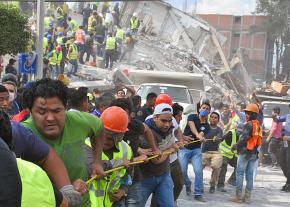Aftershocks of solidarity and opportunism
A member of the Action and Resistance Collective of Mexico describes how differently working people and rulers responded to the recent earthquakes.
THREE MAJOR earthquakes affected central and southern Mexico in September. In southern regions such as Oaxaca, Chiapas and Morelos, it has been difficult to account for collapsed buildings and people affected, but in Mexico City alone at least 38 buildings fell, leaving more than 325 people dead and thousands wounded.
The immediate response to the earthquakes, in all three cases, has been tremendous solidarity from workers and ordinary people. Immediately after the earthquake in the south, the Oaxaca teachers' union called for mobilization to support the affected people with supplies and reconstruction work.
What surprised everyone, however, was the great show of solidarity that emerged in Mexico City. Hundreds of thousands of people moved around the city to rescue their neighbors, collect food and help in any task in which they had opportunity. Workers of all kinds, from the most humble masons to the most experienced professionals--and even brigades of undocumented immigrants from Central America--showed their desire to support all those affected by earthquakes.

The fact that the transportation system stopped for the whole day did not prevent people from leaving their homes to provide support to those who needed it. As a result, it's estimated that around 70 people were rescued alive from the collapsed buildings.
But the rescue efforts have not been simple, and they've been complicated even more when the army has gotten in the way.
On the second day after the earthquake, the military attempted to take control of all affected areas in Mexico City, determined to prevent the inhabitants from organizing themselves. In some places they succeeded, but in others they were challenged by the popular organization.
The purpose of the army's intervention was not to expedite the rescue work, but to demonstrate to the media that the institutions are in charge, and also to restore the reputation of the armed forces, which has sunk dramatically in the long years of the drug war.
But as things got out of hand, the army shifted the focus from rescuing trapped people to tearing down debris. In the case of a downtown sweatshop that collapsed with about 100 workers inside, as soon as the army took control, it stated that rescue work would be too difficult, and ordered a demolition without trying to find anyone still alive or even identify the bodies of those who died.
Naturally, the volunteers protested, even with their fists, which allowed the rescue work to continue. But the conflict with the military lasted for at least three days, wasting valuable time that might have been used to search for survivors. In the end, two women workers were found alive and dozens were found dead.
In the case of another collapsed building near the city center, the army didn't wait three days but quickly demolished the entire building and replaced it with a concrete slab. The task identifying bodies was never carried out.
NOW IT'S coming to light that corruption in the construction and real estate industries played a major role in making the disaster of these earthquakes far worse.
Many of the collapsed buildings, as well as many of the more than 3,000 buildings that were seriously damaged after the earthquake, didn't comply with many construction and safety standards.
In the case of Rebsamen College, located in the south of the city, it was found that the building had been built illegally and with numerous violations of the law. This private school prioritized the extra profits to made from taking in more students over building a safe structure for them, and the result was a deadly trap for more than a thousand children between 4 and 15 years old. It's estimated that 31 children and five adults died after the collapse.
Televisa, the most important media network in Mexico, created a fictional story about a surviving girl from Rebsamen College that initially attracted audience attention. But the next day it was known that the girl did not exist and that the network had invented everything.
The difference in behavior between Mexico's classes has been very noticeable after the disaster. Unlike workers who rushed to rescue others in their community, politicians and entrepreneurs have been looking to take advantage of the situation for their own gain.
Many governors and public officials have seemed more concerned to be seen helping those affected than about what help is actually needed. Oaxaca's Secretary of Health prevented the delivery of supplies that were not from his own state's government. In the central region of Morelos, authorities set up roadblocks to intercept vehicles with supplies--not to deliver them but possibly to use them as part of their clientele apparatus for next year's national elections.
Meanwhile, businesspeople have taken the opportunity to make money. Carlos Slim, the richest man in Mexico and one of the richest in the world, declared that he would donate five dollars for each dollar donated by the public. But the money he'll end up deducting from his taxes for this philanthropy will take away from desperately needed government rebuilding efforts in the years to come.
The owner of the sweatshop that collapsed asked the authorities to do the work of demolition and removal of the debris as soon as possible, because he was in a hurry to collect the insurance money on the building.
Finally, there is the immorality of the market. Thousands of families have lost their homes and there is no sign that they will get them back. Mexico City has many apartment buildings that are empty but not affordable for most of the people affected by the earthquakes.
A solution to this problem could be expropriation of these buildings in order to give a roof to those who lost theirs. This will be an important struggle in the coming weeks.


